
Balloon release on Primrose Hill 1998

Ed Berman of Interaction in Gospel Oak 1971

Ken Livingstone relaxes in Camley Nature Park |
Caught for camera
Nigel Sutton has been the man behind the lens of some of north London’s most bizzare and beautiful moments, writes Ruth Gorb
You name it, he was there. When John Betjeman relieved himself in the disused lavatories of Highgate school, he invited Nigel Sutton to take a picture of him – from the back.
When Cassius Clay trained in the gym behind The Noble Art pub in Haverstock Hill, Nigel Sutton caught him on camera. He has photographed royals, countless actors and politicians, Nobel Prize winners, Mother Teresa and the Dalai Lama (twice) not to mention a roller-skating parrot. And if this part of London has had more of its share of the famous and the infamous, the bizarre and the beautiful, it has had the luck to have Nigel Sutton recording them all on film.
An exhibition celebrating his work starts next week at Lauderdale House in Highgate. For 40 years he has been a press photographer. Something happens, and it’s “Where’s Nigel?” Don’t worry, he’ll stroll in, ever dependable, totally unflappable. He is never nervous, he says, however illustrious the subject of the occasion.
He was taught by an old pro-photographer, Doug Fuller, whose advice was, “get stuck in there and make your presence felt. And if nothing happens, you’ve got to make it happen,” he says.
North-west London is his patch now, but he was born and bred in Kent. It was a friend of his father’s a pilot photographer from the RAF, who first got him interested in photography, and from the start young Nigel had a nose – and an eye – for a good story. He was only 14 when he took a picture of a bad accident on Romney Marsh. The police were impressed. “From then on I was asked to take pictures of accidents for the local fuzz.”
He worked his apprenticeship in Kent, and when he was 19 answered an ad for a job in north London.
Coming to Hampstead was a culture shock. He was a country boy and he was dazzled and a little bemused by the cosmopolitan world he had been plunged into. He lived first in a bedsit in Kemplay Road, then moved to Marlborough Terrace, St John’s Wood, where he shared a fairly dilapidated house with a bunch of journalists and musicians. It was the ’60s, and it was fun.
Work was fun too, and it came fast and furious. Nigel Sutton could be photographing a bishop one minute, and an angry demo the next. He had his share of those, he says. One of the best (from a photographer’s point of view) was the sight of thousands of women, plus attendant baby buggies, streaming over Hampstead Heath in protest against the lack of natural childbirth facilities at the Royal Free Hospital.
Some things, he says, stick in his mind. There was the 100-year-old in the old people’s home who was told to “smile at the nice camera man, dear” and his response was, “Oh, f*** off.” He got his picture, of course. And he also got several of the literary lady who would only be photographed when lying flat on the floor – “Instant face-lift darling,” she said.
Women love him. Well perhaps not quite all of them; he was refused entry to a women’s motorcycle maintenance workshop because he was a man. But the rest say that his quiet and sympathetic presence makes them relax and results in the best photographs they’ve ever had taken.
How does he manage to make women look so good? “I just like women,” he says. Who is the most beautiful he has ever photographed? Only a very slight hesitation: “Gayle Hunnicutt.”
He has an eye for beauty, and an eye for the quirky side of life. Those, he says, are his favourite subjects: barrel-rolling on Hampstead Heath; the little boy who ran a guinea pig club and held a show in his parents’ front room in Highgate – he got so many members of the club that the next year he had to move the show into a church hall. Ordinary people doing extraordinary things – not celebs – are what he likes But where, he wonders, are the Hampstead eccentrics of yesteryear?
Yes, there are plenty of big names here now. But he is not the sort of photographer who waits outside a supermarket to see a celebrity coming out with carrier bags. “It’s just not that interesting,” he says. “And I am certainly not in the business of papparazzi-style persecution of celebs. If Jamie Oliver wants a quiet pint in the Hollybush, he’s entitled to his privacy.”
He feels that his job is to photograph people because they do something, not just because they are famous, or just because they live here. He runs through the names of celebrities who contribute to the community. “Tom Conti, Jon Snow, Micheal Palin, Bill Oddie, Simon Callow, Janet Suzman, Roger Lloyd-Pack. They support local causes, they turn up to give prizes, they care about their neighbourhood, and they’re worth photographing,” he explains.
What he doesn’t know about the neighbourhood isn’t worth knowing. He has been in every church, school and public building, he has photographed every mayor of Camden since Camden began, he knows every parking place in north-west London. He also has a disconcerting habit of asking a interviewee exactly the right question, the one the reporter didn’t think of.
Laid back to the point of self-deprecation, he says it’s better than working for a living. And it has its moments. Arriving at a job in one of the swankier streets in Hampstead, the front door was opened to him by the au pair. She was quite naked. “She obviously thought it was normal. I pretended I hadn’t noticed.” Ever the gentleman.
|



